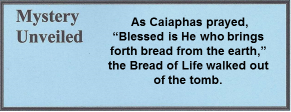18.01.01 Introduction
Early on Sunday morning Caiaphas woke up believing that he was relieved of his biggest fear: Jesus was dead and His ministry was destroyed. But he was about to receive the surprise of his life. He put on his priestly robes, went to the temple, and performed the wave offering before the altar of the Lord, just as Moses commanded:
10 “Speak to the Israelites and tell them: When you enter the land I am giving you and reap its harvest, you are to bring the first sheaf of your harvest to the priest. 11 He will waive the sheaf before the Lord so that you may be accepted; the priest is to wave it on the day after the Sabbath.
Leviticus 23:10-11
In compliance with the Law, Caiaphas went in all manner of pomp and circumstance, was given a sheaf of freshly harvested barley, because the harvest always ended just prior to Passover. Precisely at sunrise he was in the temple and stood before the altar of the Lord, waved the sheaf offering and prayed,
Blessed is He who brings forth bread from the earth.
Priestly Temple Blessing[1]
When he recited the blessed prayer there was an incredible earthquake, the stone was rolled away from the tomb, and the Bread of Life walked out of the grave. Life eternal had come to humanity while the biggest nightmare of Caiaphas had just begun.

Upon coming out of the tomb, Jesus then began to minister to those who placed their faith in Him; who accepted Him as the true Messiah. He then appeared to many as follows.[2]
- To Mary Magdalene (Jn. 20:11-17)
- To the other Mary and Salome (Mt. 28:9-10)
- To Peter (Lk. 24:34)
- To the two disciples on the way to Emmaus (Lk. 24:13-32)
- To the 10 apostles (Lk. 24:33-49)
- To Thomas and the other 10 apostles (Jn. 20:26-30)
- To the 7 apostles (Jn. 21:1-25)
- To all the apostles in Galilee (Mt. 28:16-20)
- To 500 brethren (1 Cor. 15:6)
- To James (1 Cor. 15:7)
- To the 11 apostles before His ascension (Acts 1:4-9)
- To the Apostle Paul (1 Cor. 15:8)
18.01.01.Q1 What is the significance of His resurrection?
The significance is so dynamic, that the brief description below clearly does not provide justice. However, this theological question is briefly answered in outline form to focus on the main points.
- It means the forgiveness of the believer’s sins and eternal life for him (1 Cor 15:7).
- It guarantees the judgment of all unbelievers (Acts 10:40-42; 17:30-31).
- It assures the resurrection of all men, both believers and unbelievers (1 Cor. 15:20-23)[3]
- It proves our justification (Rom. 4:24-25)
- It guarantees power for believer’s service (Ephesians 1:17-20)
- It designates Jesus as the Head of the Church (Eph. 1:20-22)
- It means that Jesus has the keys of death as far as believers are concerned (Heb. 2:9-18; 1 Thess. 4:13-15).
- The sin-nature of the believer is rendered inoperative. It is not removed when one believes, but it is judged and condemned (Rom. 6:1-10).
- It means that there is now a sympathetic High Priest in Heaven (Heb. 4:14-16)
These nine points, and there could be more, point to the fact that the Kingdom of God is within the believer. These underscore the close relationship Jesus desires with every believer and the incredible price He paid for that to occur.
[1]. Acording to Ann Spangler and Lois Tverberg Sitting at the Feet of Rabbi Jesus, 215-17, 241, about the time that the Jerusalem Talmud was written (300 — 400 A.D.), the blessing was changed to what is commonly used in synagogues today: “Blessed are You, Lord, our God, King of the Universe, who brings forth bread from the earth.”
[2]. Adapted from Geisler. “The Significance of Christ’s Physical Resurrection.” 157 n33.
[3]. For believers, it guarantees individual resurrection (Rom. 8:11; 1 Cor. 6:14; 2 Cor. 4:14).